Victoria & Albert Museum: Top 12 Highlights
Vast and relentlessly eye-opening and pleasing, the Victoria & Albert Museum is the world’s largest museum of decorative arts & design. This ‘Victoria & Albert Museum – Top 12 Highlights’ will hopefully give you an easy-to-follow intro of sorts and a bit of focus for your first visit.
Admission is free: 10.00am – 6.00pm.
Here is the London Explorer’s Top 12 Highlights of the Victoria & Albert Museum.
The V&A houses a permanent collection of over 2.27 million objects, covering 12.5 acres in 145 galleries. Its collection spans 5,000 years of art, from ancient times to the present day and from the cultures of Europe, North America, Asia and North Africa.
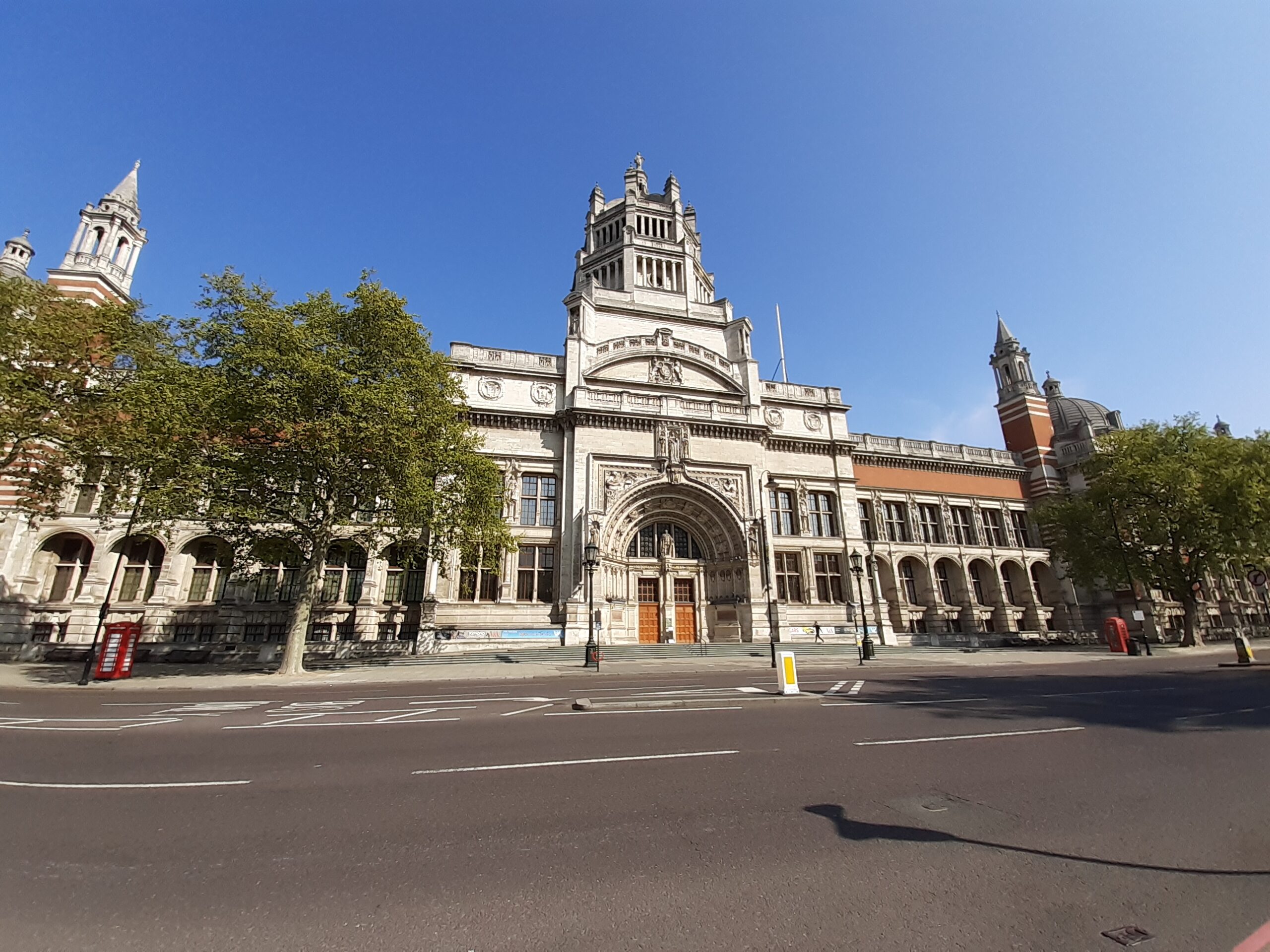
Victoria & Albert Museum
The museums holdings of ceramics, glass, textiles, costumes, silver, ironwork, jewellery, furniture, medieval objects, sculpture, prints and printmaking, drawings and photographs are among the largest and most comprehensive in the world.
Where did this obsessive urge to collect begin? It started in the 1840s as the Museum of Ornamental Art and the School of Design – housed in separate buildings. One of the original ideas behind these museums was to collect works which British designers, engineers and inventors could study so that British ingenuity, skills and manufacturing could continue to lead the world.
In 1857 they relocated to South Kensington into over 80 acres of land purchased to continue the aims of the 1851 Great Exhibition (‘to extend the influence of Science & Art upon Productive Industry’). Buildings for museums, concert halls, colleges and learned societies had begun to develop in land close to the Great Exhibition, an area that became known as ‘Albertopolis’ after Prince Albert – he had been the primary motivator for the Great Exhibition.
Both museums were housed in buildings that became known as the ‘Brompton Boilers’ (cast iron, sheet iron and glass by William Cubitt; which btw later moved to Bethnal Green and was repurposed for the Museum of Childhood).
In 1890 a new permanent building was planned; Aston Webb was selected as architect and in 1909 it was opened by Edward VII. The building we see on Cromwell Road is terracotta brick surmounted by a 56 metre central tower, shaped like an imperial crown. The full site however goes much further back up Exhibition Road.
Statues of Victoria & Albert are above the entrance and either side is Edward VII and Queen Alexandra. The statues featured in the niches were by students at the Royal College of Art (also in Albertopolis) and are as follows:
Painters: Millais, Leighton, Watts, Reynolds, Hogarth.
Sculptors: Gibbons, Flaxman, Chantrey, Foley.
Architects: Barry, Chambers, Wren, Jones.
Craftsmen: Morris, Wedgewood, Chippendale, Caxton, Tompion.
There has always been a tension between the museum’s original mission and what is actually inside – there is no central focus. Which doesn’t diminish its enjoyment.
Level 0 (Ground)
- V&A Rotunda Chandelier: 1999 – Entrance, Dome.
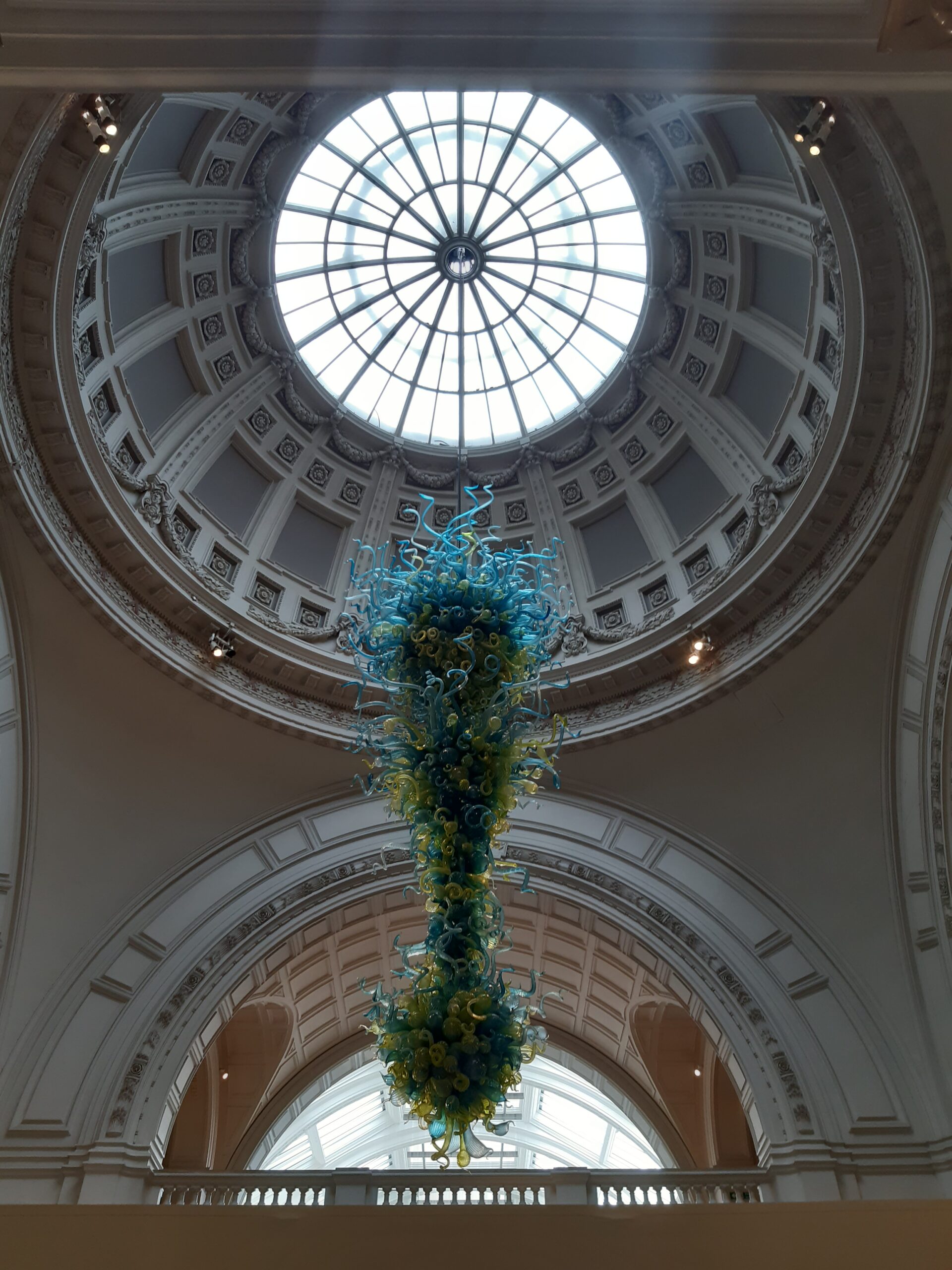
V&A Rotunda Chandelier
We start with the new. The V&A Rotunda Chandelier is a hanging blown-glass sculpture by Dale Chihuly really called ‘Ice Blue and Spring Green Chandelier’. You can’t miss it as it hangs under the glass rotunda at the entrance to the V&A. Considered to be an artwork as much as a source of light, it was installed in 1999 and then altered and enlarged to its current size in 2001.
Before the chandelier could be installed the V&A had to reinforce the ceiling and cleaning requires special care. It is cleaned piece by piece by a technician on a raised platform using an antistatic wand made of plastic filaments. This has to be carried out before the museum opens during a process that takes several days.
- Raphael Cartoons: 1516 – Level 0, Rm 48a.
The Raphael Cartoons are seven large preparatory prints, or cartoons, for tapestries destined for the Sistine Chapel in Rome. Designed by the genius Renaissance artist Raphael in 1515-16 the cartoons show scenes from the lives of Saint Peter and Saint Paul. They are the only survivors of a set of ten cartoons commissioned by Pope Leo X for the Sistine Chapel tapestries in the Vatican Palace, which are still (on special occasions) hung below Michelangelo’s famous ceiling. The cartoons belong to the Royal Collection but since 1865 have been on permanent loan to the V&A.
Raphael was conscious that his work would be seen beside the Sistine Chapel ceiling which had been completed shortly before and took great care perfecting his designs which are among his largest and most complicated. The tapestries were made with both gold and silver thread and some were burnt during the Hapsburg’s Sack of Rome in 1527 to extract the precious metals.
The cartoons are painted on sheets of paper glued together and mounted on a canvas backing. They measure slightly over 3 metres tall and from 3 – 5 metres wide. Some colours have lost their vibrancy, but they are generally in excellent condition.
The seven cartoons in the V&A were bought from a Genoese collection in 1623 by King Charles I whilst still Prince of Wales. He paid only £300 for them, which suggests they were regarded as working designs rather than works of art. Charles had further tapestries made from them at the Mortlake Tapestry Works (now part of London). They had been cut into long vertical strips a yard wide, as was required for use on low-warp tapestry looms and were eventually re-joined in the 1690s.

Raphael Cartoons, Victoria & Albert Museum
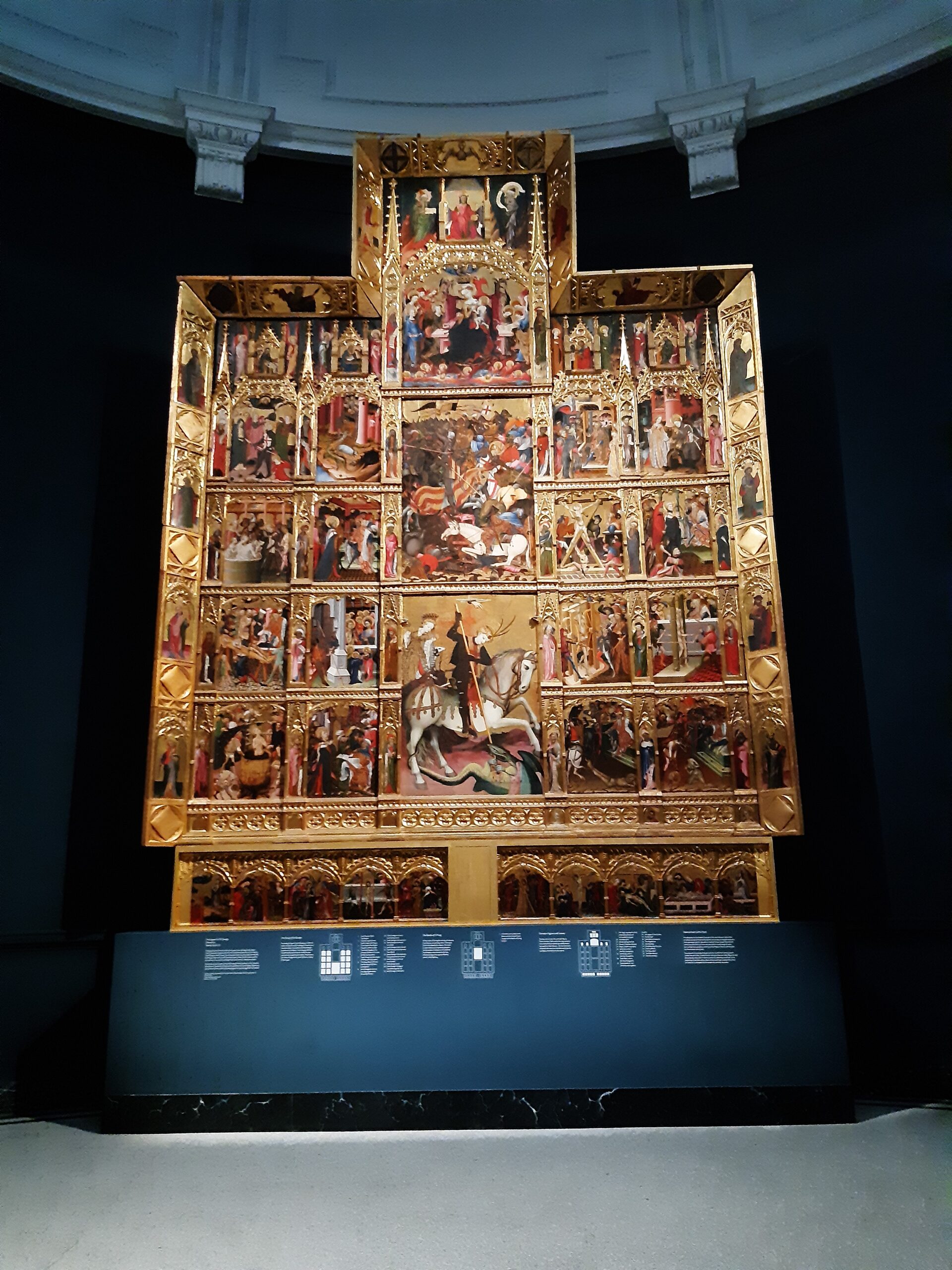
The Legend of St George Altarpiece
- The Legend of St George Altarpiece: 1420s – Level 0, Rm 48a.
This huge altarpiece illustrates the legend of 3rd century Saint George, a martyred saint and warrior – and now of course patron saint of England. It has three central panels surmounted by the Holy Spirit and Christ flanked by Moses and Elijah. Each side depicts ten scenes from the life of St George, including the (mythical) slaying of the dragon, his martyrdom by decapitation and his legendary contribution to the founding of Valencia – he is supposed to have come to the aid of the Christian army at the Battle of El Puig (1237), during the reconquest against the Moors. The predella (bottom) panel illustrates ten scenes of the Passion (crucifixion, entombment and resurrection).
The altarpiece is a grand example of the Valencian school of the International High Gothic style (rich colours, gold decoration). Attribution is disputed but was it was probably commissioned by the Confraternity of the Centaur de la Ploma, a civic militia.
- Gallery of Fashion – Level 0, Rm 40.
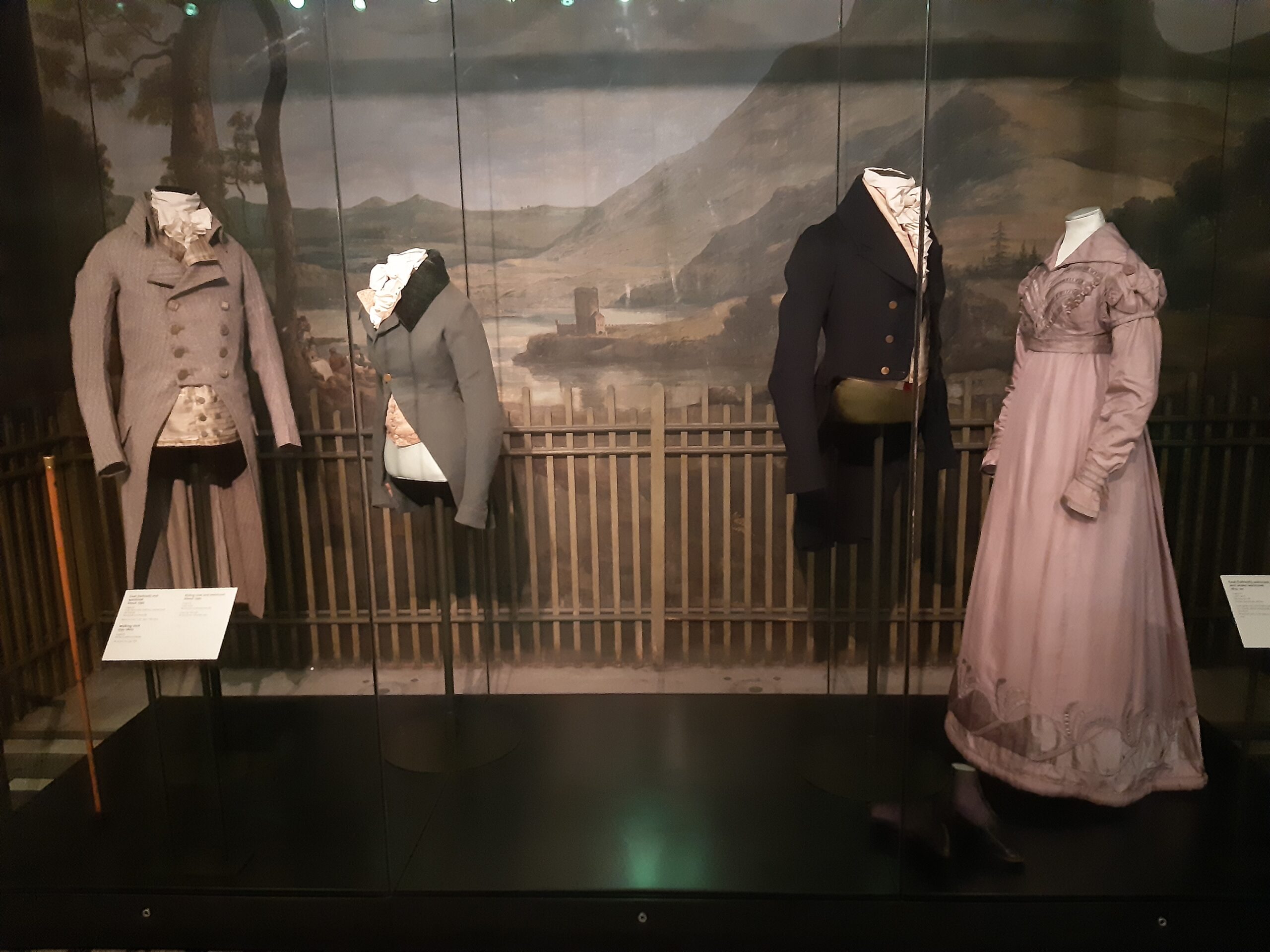
Gallery of Fashion, Victoria & Albert Museum
If you’ve ever wondered how we know so much about clothing from the past this collection provides huge amounts of knowledge and inspiration. The V&A’s Fashion Collection is the most comprehensive in the world, housing unrivalled collections of dress, accessories, shoes and hats from the 17th century to the present day. The collection contains over 14,000 outfits plus accessories – only a small part is on display. Key items include rare 17th century gowns, 18th century ‘mantua’ dresses, 1930s eveningwear, post-war and 1960s daywear.
The collection contains mainly European fashion and accessories for men and women, together with important items of 19th century dress for the elite in India, China and Japan. The collection also includes a wide range of accessories from across the world, including footwear and hats.
- Tipu’s Tiger: 1795 – Level 0, Rm 41 (South Asia).
The Tipu Sultan hated the British East India Company and this ‘playful’ effigy certainly does project his extreme dislike very effectively. Tipu’s Tiger is a mechanical toy created for Tipu Sultan, the ruler of the Kingdom of Mysore in India in 1795. The carved and painted wood casing represents a tiger savaging an almost life-size European man. It makes imaginative use of Tipu’s personal emblem of a tiger – almost like he was the tiger!
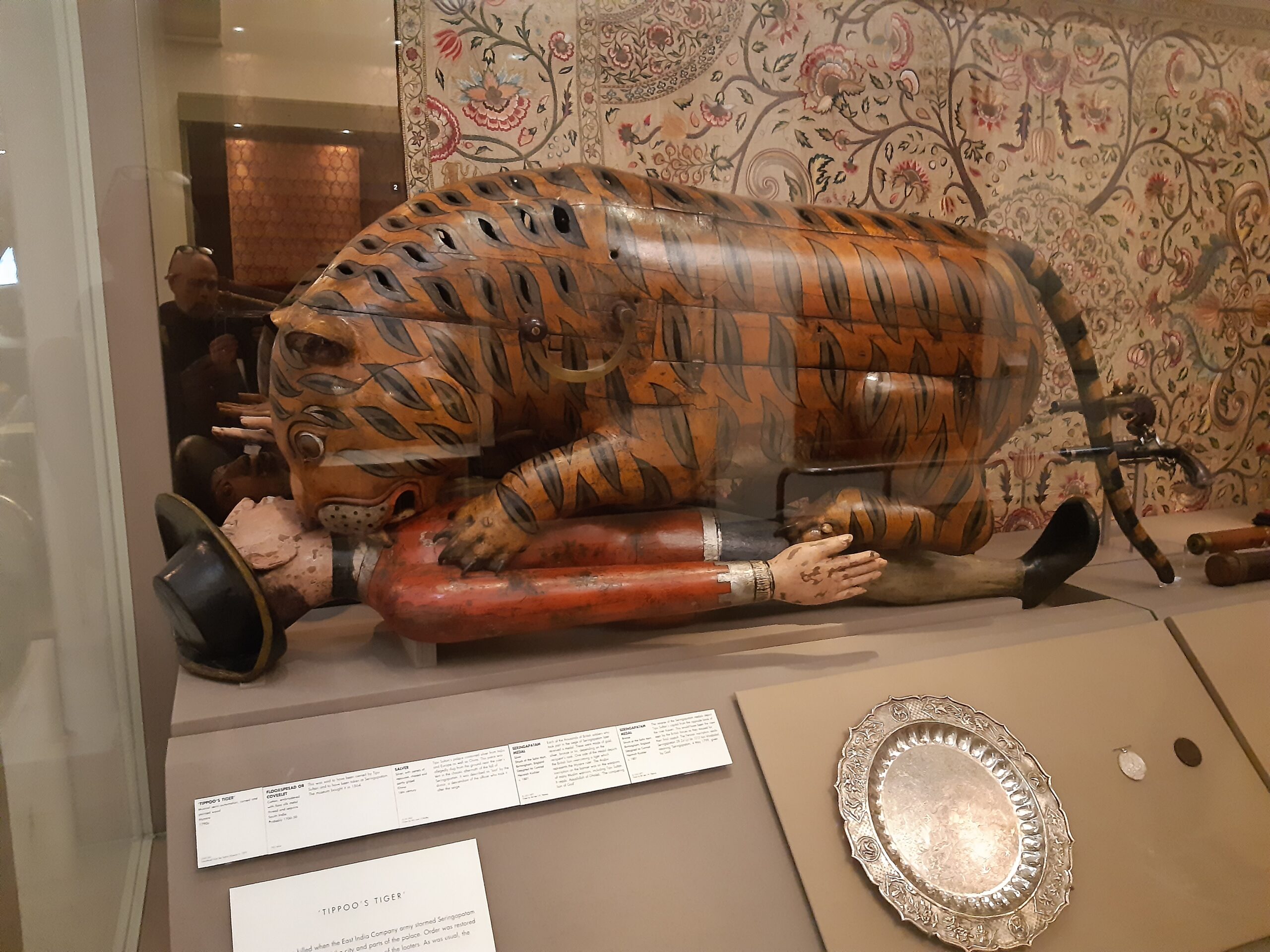
Tipu’s Tiger, Victoria & Albert Museum
Mechanisms inside the tiger and man’s body make one hand of the man move, emit a wailing sound from his mouth and grunts from the tiger. A flap on the side of the tiger folds down to reveal the keyboard of a small pipe organ with eighteen notes.
Tipu had inherited power from his father Hyder Ali, a Muslim soldier who had risen to become commander-in-chief under the ruling Hindu Wodeyar dynasty, but who from 1760 was in effect the ruler of the kingdom. Hyder was initially allied to the British against the Marathas, but later become their firm enemy as they represented the biggest obstacle to the expansion of his kingdom.
The tiger was discovered in Tipu’s summer palace after East India Company troops stormed his capital in 1799, at the culmination of the Fourth Anglo-Mysore War. First exhibited in London in 1808 in East India House in London, it was transferred to the V&A after the dissolution of the Company in 1874.
6 & 7. Cast Courts – Level 0, Rm’s 46a and 46b.
The Cast Courts represent those early days of the V&A when it was a place of study and enquiry for artists, designers and manufacturers. It comprises two large halls, housing a collection not of originals but copies, reproductions of some of the most famous sculptures in the world. Most of the copies were made in the 19th century. Some are in better condition than the originals and in a few cases the originals have been destroyed and the cast is a unique record of a lost work.
In Britain, from 1841 onwards a collection of art from all periods and countries was being assembled by the School of Design. In 1852 this collection was taken over by the Museum of Manufactures, based then at Marlborough House. In 1857 the museum moved to its current location in South Kensington. In 1862, the collection was enlarged by the acquisition of over 2,000 casts of decorative wood carving that had been used as examples for the craftsmen working on the new Houses of Parliament.
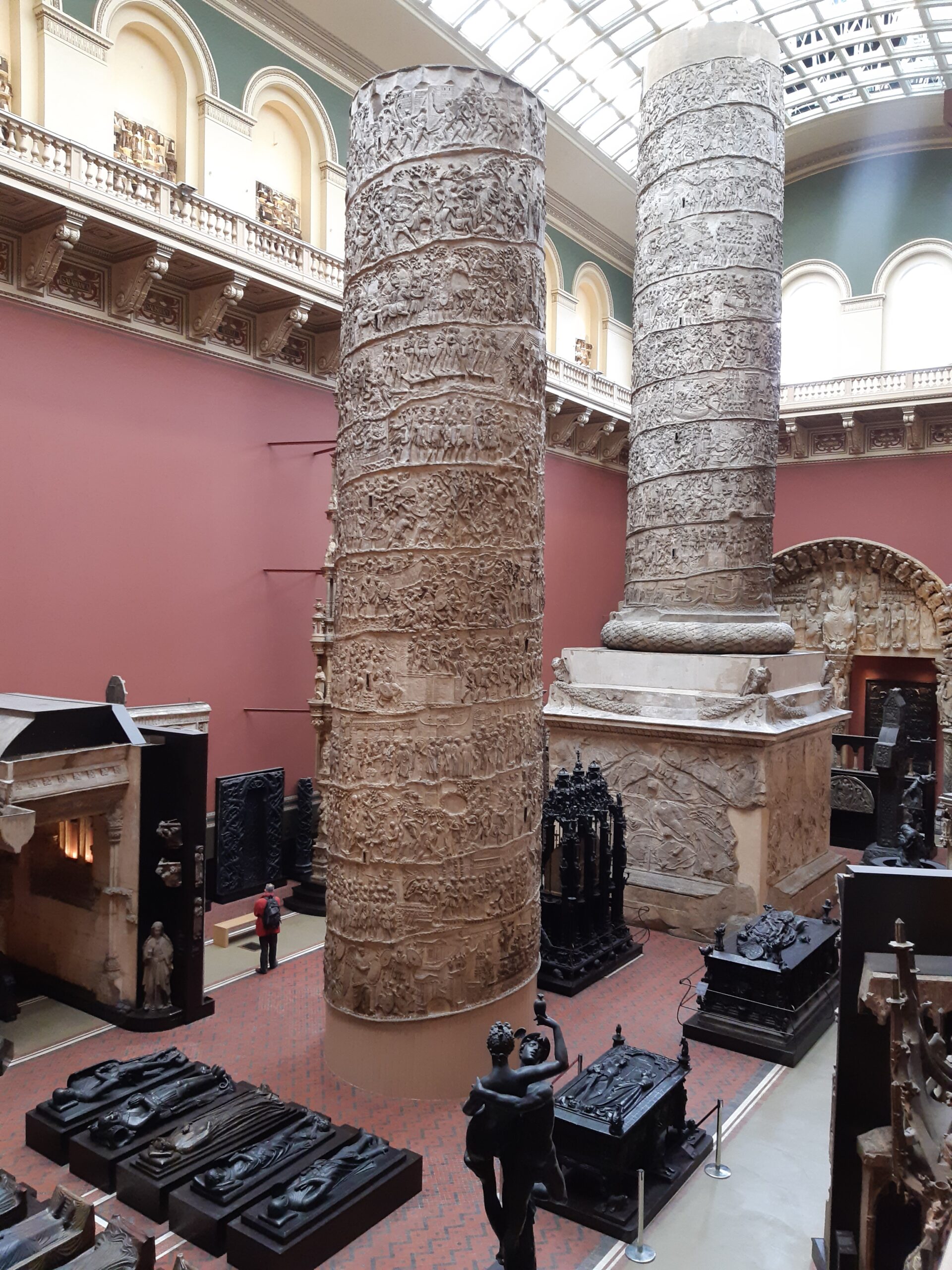
Trajan’s Column, Victoria & Albert Museum
Trajan’s Column: 1864.
Too high to fit, Trajan’s Column is divided into two roughly equal parts. The original column in Rome is 30 metres high and includes an internal spiral staircase which leads to a viewing platform at the top. This cast is of the huge pedestal and the entire column but excludes the platform. An original statue on the top was lost in antiquity. The pedestal is covered in illustrations of booty from the Dacian Wars (Romania) and the column is covered in a frieze illustrating the conquest of Dacia by the emperor Trajan.
The frieze describes in narrative form two wars against Dacia: 101-102 AD is illustrated in the lower section of the column and 105-106 AD in the upper section. The V&A column was cast in small parts and these parts were reassembled on brick chimney-like structures built especially for the purpose.

David, Victoria & Albert Museum
Three Davids.
Michelangelo’s David (1501) was the museum’s first major cast of Italian figure sculpture. It was sent as a gift in 1857 from the Grand Duke of Tuscany to Queen Victoria. The gift was unexpected and the Queen promptly gave the cast to the South Kensington Museum which is now the V&A.
In the reign of Queen Victoria the display of male nudity was considered risque and the Queen herself was said to find it shocking – although this is disputed. All the same, the museum commissioned a well-proportioned fig leaf that was kept in readiness in case of a visit by the Queen or other female dignitary; the fig leaf would then be hung on the figure using a pair of hooks. It is still displayed in a case on the back of the plinth.
Donatello’s bronze statue of David (circa 1440s) is notable as the first unsupported standing work in bronze cast since classical times. The cast is painted to resemble the bronze of the original. A third image of David is a cast of David by Verrocchio.
- V&A Café: 1868+ – Level 0, Morris, Gamble and Poynter Rooms.
Three refreshment rooms – the Gamble, Poynter and Morris Rooms – were opened to the public in 1868 all decorated in shimmering and vibrant expanses of coloured glass, enamel and tiling. They remain fantastic spaces in which to dine, have a cream tea (scone, jam and clotted cream) or coffee and cake.
The Gamble Room.
Sculptor James Gamble took charge of the large, ornately decorated central café. The enamelled ‘majolica’ tiles were made from pottery decorated with coloured lead glazes. In fashion since the 1851 Great Exhibition ‘English tin-glazed majolica’ imitated a process used since the Italian Renaissance. Other decorations included a frieze of ‘putti’ (cherubs) harvesting food, dining and reading newspapers; grand mirrors in majolica frames; carved scenes with elephants and camels surrounding the doors; and stained-glass windows to hide the kitchens and art school buildings behind. The ceiling is decorated in enamelled iron sheets.
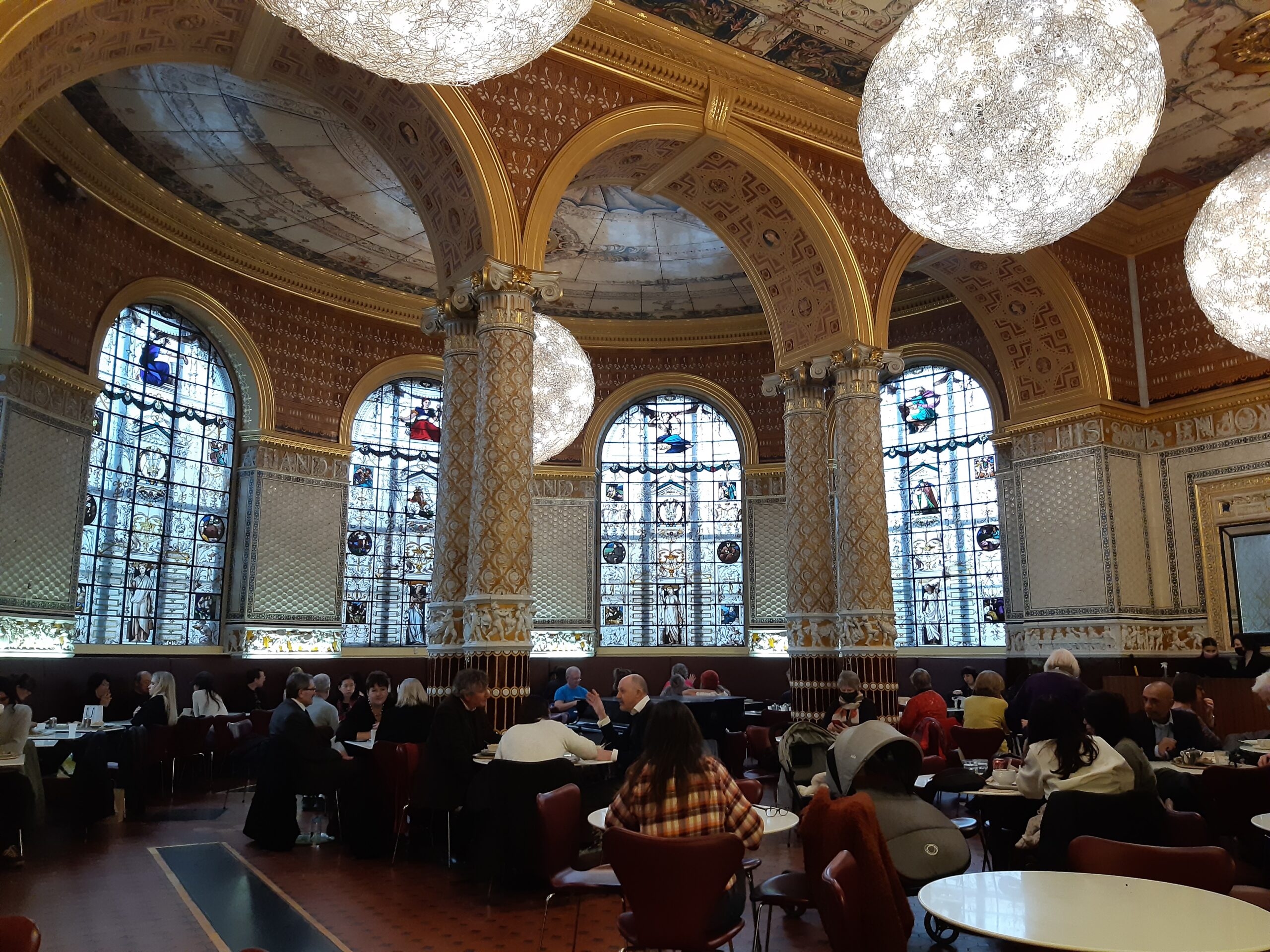
V&A Café
These materials were meant to both dazzle and be practical. They were selected to resist fire, steam and food odour and they were easy to clean. The iron ceiling plates also formed a fireproof cell within the Museum. Very sensible.
The Poynter Room.
The small Poynter Room to the east of the Gamble Room was fitted out to ‘broil chops and steaks’. Painter Edward Poynter was chosen as designer. A cast-iron open range with an open grill dominated one wall, with ‘hot chambers’ on either side where plates were warmed. Poynter also used glazed ceramics on the walls, mostly with a Dutch blue paint. The tiles were painted by female students from the National Art Training School. This was unusual at the time in that it was a public commission for women; they were each paid between six and nine pennies per hour.
Poynter contrasted his room to Gamble’s with eastern influences in the wave patterns, floral and peacock motifs. On the upper walls painted tiles represent the months and seasons and signs of the zodiac. Below, fruit and flowers are interspersed among portraits of women from classical literature, including Helen, Venus, Medea and Sappho.
Customers would choose from different restaurant menus, divided according to social status! The first-class menu included items such as jugged hare (1 shilling and sixpence), steak pudding (1 shilling) and seasonal tarts (half a shilling). On the second-class menu were veal cutlets (10 pennies), poached egg and spinach (1 shilling) and buns and sponge cake (one penny).
The Morris Room.
William Morris became one of the most famous designers of the Victorian period but when designing the ‘Green Dining Room’ he was still a newcomer. Morris, who later became famous for his leadership of the Arts and Crafts Movement, suggested themes influenced by Gothic features and Elizabethan-style panelling.
The room is circled in a plaster relief of olive boughs and a frieze of hounds chasing hares. Morris’s friends, architect Philip Webb and soon-to-be famous painter Edward Burne-Jones, helped with the decoration. Webb was inspired by a wide variety of medieval and ecclesiastical sources, while Burne-Jones used the signs of the zodiac and images of medieval women performing domestic tasks. Morris and Webb collaborated on the ceiling, which was covered in geometric patterns and floral arabesques pricked into the wet plaster. The windows of bullseye bottle glass were conceived by Webb, with stained-glass figures designed by Burne-Jones.
Level 1 – British Galleries
- Henry VII bust: 1509 – Level 1, Rm 58.
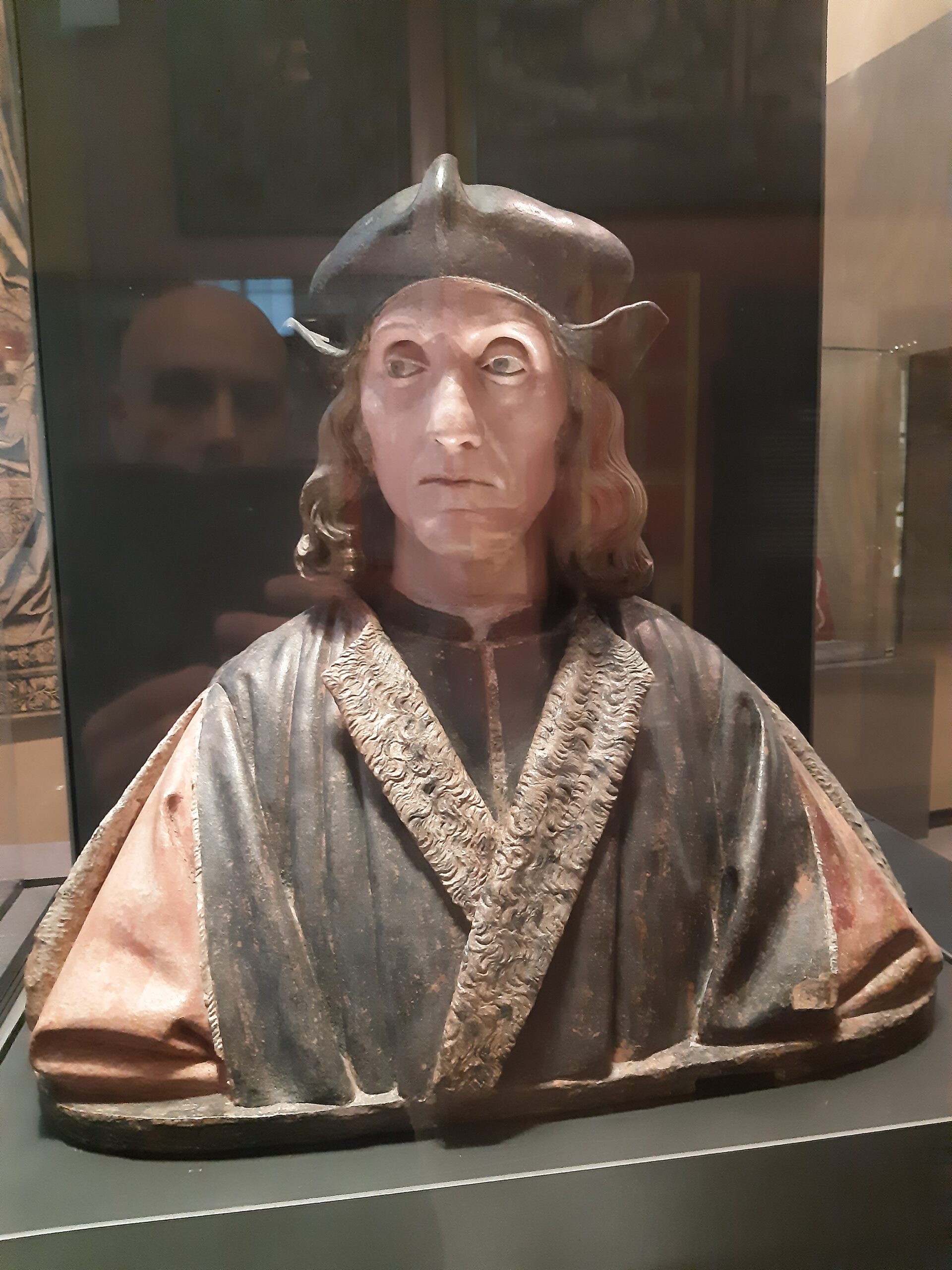
Henry VII Bust, Victoria & Albert Museum
Pietro Torrigiani left Italy and arrived at the court of Henry VII in ‘barbarian’ Britain. He was the man who broke Michelangelo’s nose in a fight.
Henry VII was Torrigiani’s great British subject. His tomb for Henry and his wife is in Westminster Abbey and is a key Renaissance work in Britain. Henry VII always had a reputation for cunning and caution and this lifelike bust does not shatter the myth. He has a natural, slightly sallow pallor with watchful hooded eyes and thin lips. This is actually an image of a dead man in painted terracotta. Torrigiani took his likeness from Henry’s death mask.
Henry was not glamourous. He had won the throne in battle and after victory in the Wars of the Roses his efforts went into creating a centralised state and a new royal dynasty, the Tudors. We see here a determined and notoriously careful man.
The sophisticated Italian sculptor has adapted his style to Britain’s more low-key culture. Despite being copied from a death mask it is full of life and is animated by techniques specific to Renaissance Italian sculpture, such as the way Henry looks to the side in a very natural pose.
- Great Bed of Ware: 1590 – Level 1, Rm 57.
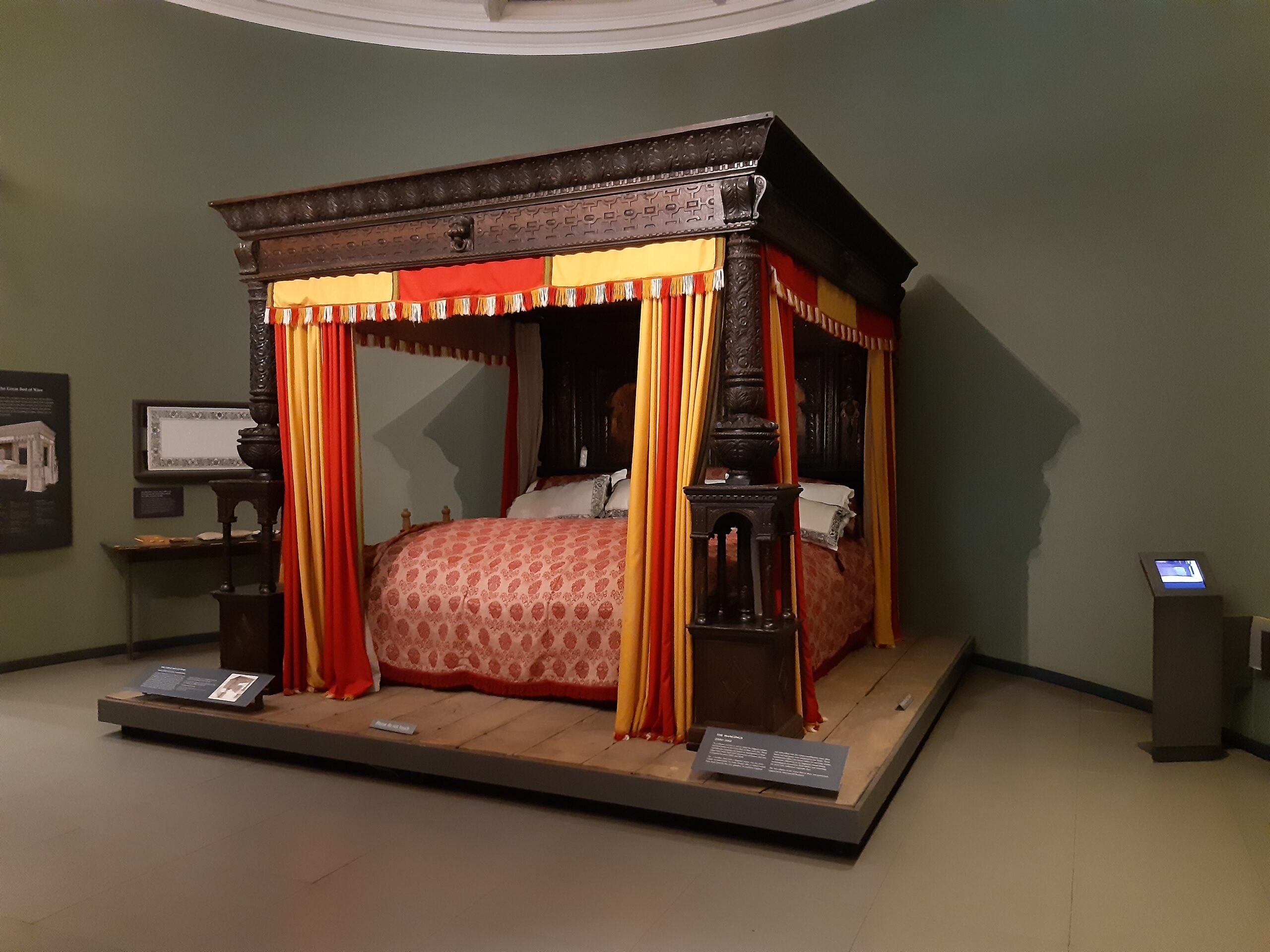
Great Bed of Ware, Victoria & Albert Museum
I can tell what you’re thinking: did I come all the way to London just to look at a bed? Well, yes you did. The Great Bed of Ware is an enormous oak four poster bed, carved with marquetry, that was originally housed in the White Hart Inn in Ware, Hertfordshire. Built by carpenter Jonas Fosbrooke in about 1590 the bed measures 3.38 metres long and 3.26 metres wide and can accommodate at least four couples – why I do not know. Lots of those who have used the bed have carved their names into its posts. It was a curio object of luxury then and I think it still is.
The beds carvings and patterns are influenced by Renaissance and Dutch ornamentation. It would have been brightly painted and traces of colour can still be seen on the figures on the bedhead. The panels were probably made by English craftsmen working in London in the late Elizabethan period although the bed-hangings are modern re-creations of period fabrics.
By the 19th century the bed had been moved from the White Hart Inn to the nearby Saracen’s Head Inn. From the 1870s it passed through various owners until in 1931 it was acquired by the V&A. The V&A had turned down an opportunity to purchase the bed in 1865, describing it then as a ‘coarse and mutilated relic in no wise appropriate as a new acquisition’.
- Stoke Edith Wall Hanging: 1710s – Level 1, Rm 54.
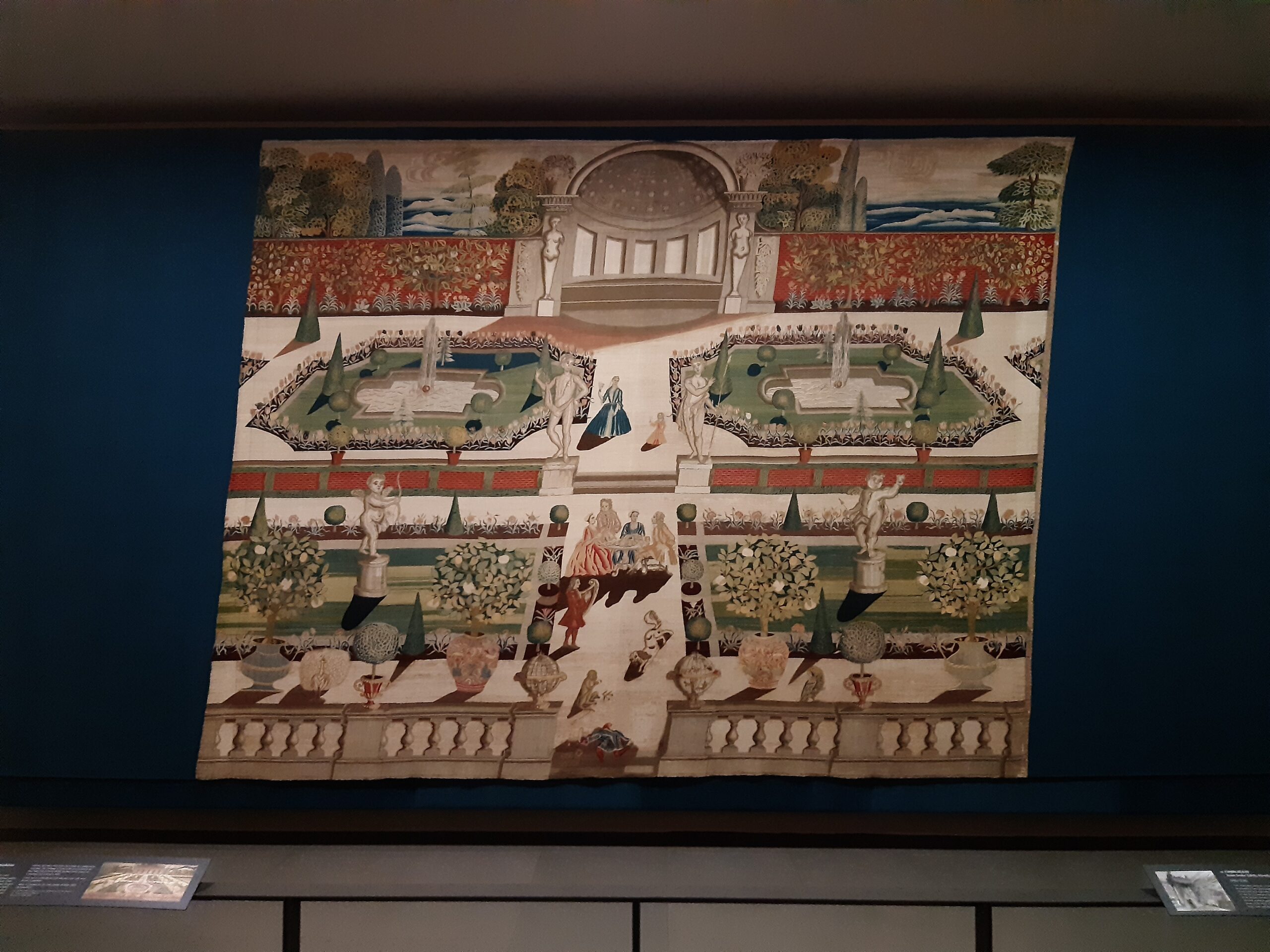
Stoke Edith Wall Hanging, Victoria & Albert Museum
The Stoke Edith Wall Hanging is a large, embroidered wall hanging made in 1710–20, depicting elegant people walking in an early 18th century garden. Is it just me or does it still look incredibly modern? It’s almost like a piece of late 19th century naïve art. The hangings are worked mainly in tent stitch in silk and wool on a linen canvas background and there are some areas of applique with chain stitch. The design was drawn onto the canvas prior to embroidery.
Stoke Edith House was built in 1697 for Paul Foley, Speaker of the House of Commons, and finished by his son Thomas, an MP and wealthy landowner. The gardens of the house were remodelled in 1692, laid out around the house in a series of formal compartments with geometric walks, flowerbeds and fountains. This was the French style very popular with British royalty too and this is what we see in the hanging. The hangings were originally displayed in the green velvet bedroom. The house was destroyed by fire in 1927, after which they were kept by the Foley family in London.
The hanging shows family members strolling, with long shadows suggesting a late summers day. Embroidered hangings were used like woven tapestries, lining the walls of a room with decorative, narrative scenes with the idea of bringing the country or garden inside the house – today the fashion is to take the house into the garden.
Level 2 – Paintings
- The Leighton Frescoes – Level 2, Room’s 107 & 102
Frederic Leighton, 1st Baron Leighton (1830 – 96).
There is the one bit of trivia people tend to know about Frederic Leighton. He was the holder of the shortest-lived peerage in history; after only one day his hereditary peerage became extinct because he promptly died (of coronary heart disease since you’re asking). He’d never married or had children. Leighton was immensely successful and popular although the family fortune had originally been made by Sir James Boniface Leighton, Leighton’s grandfather, who had been physician to two Russian tsars: Alexander I and Nicholas I.
Known as Sir Frederic Leighton between 1878-96, Leighton was a painter and sculptor associated with both the Pre-Raphaelite Movement and the Aesthetics ‘cult of beauty’. His works tended to depict historical, biblical and classical subject matters and would sell for very high prices.
Leighton’s V&A frescoes ‘The Arts of Industry as Applied to War’ and ‘The Arts of Industry as Applied to Peace’ celebrate human artistic achievements and the industrial arts (reflecting the V&As purpose). Neither tells a specific story.
War portrays noblemen, a princess and courtiers of an Italian Renaissance city state setting out for battle. The industrial arts are represented in swords, armour and banners. Peace is set in a classical world of order and plenty. It is designed to evoke a sense of beauty and depicts a central group of wealthy elegant women dressing with jewellery while, either side, workmen unload luxurious carpets and ceramics from barges.
The two frescoes were commissioned in 1868 as the central feature of elaborate decorations for the V&As South Court. These two enormous works each measure 10.7 metres across. Leighton’s work is very skilled, encompassing large-scale design, technique, sophistication and a sensuous depiction of the human body. Not many visitors wander up to the superb second floor galleries but going to see these works gives us a reason.
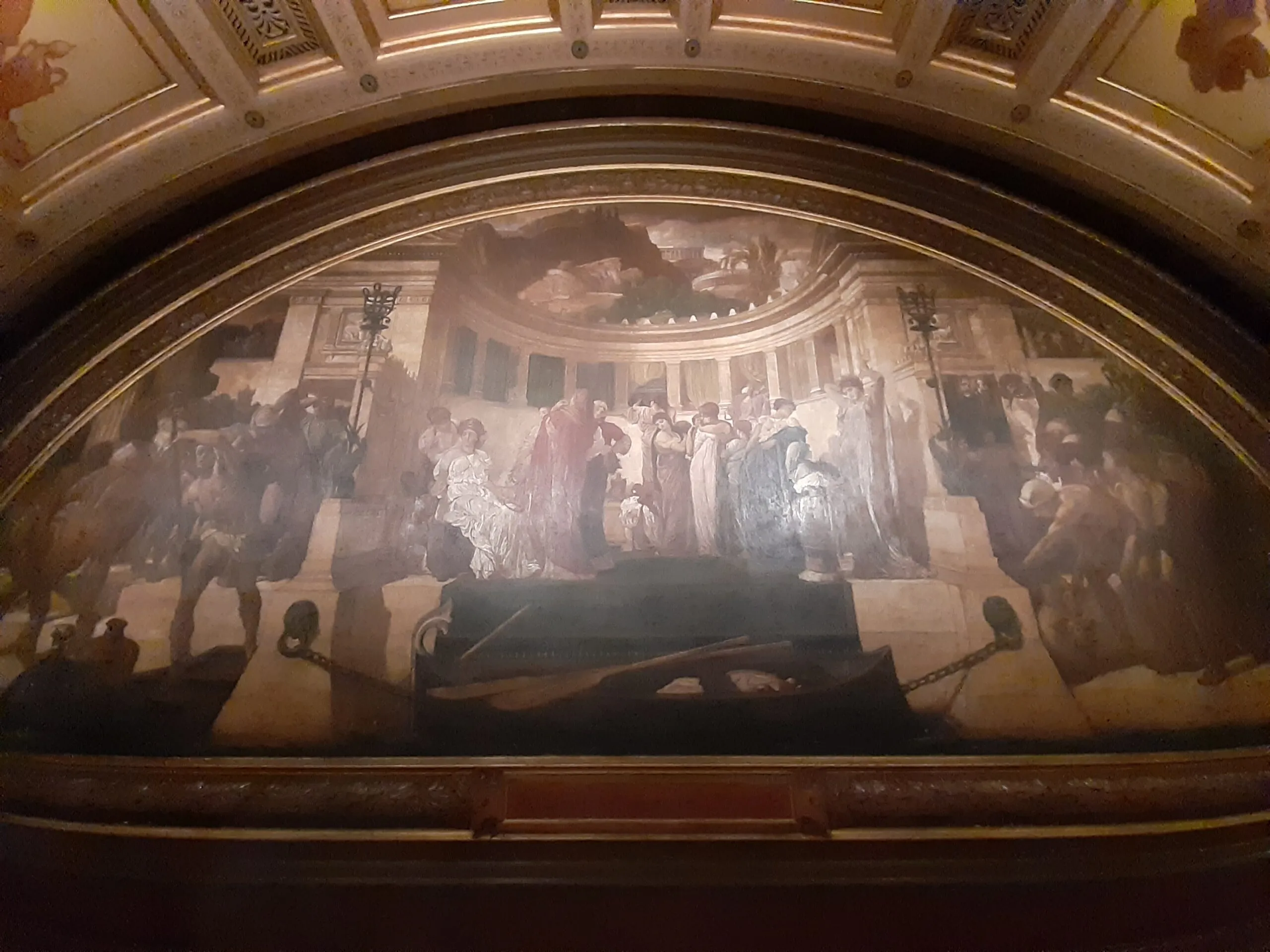
Leighton’s Wall Fresco, Victoria & Albert Museum
